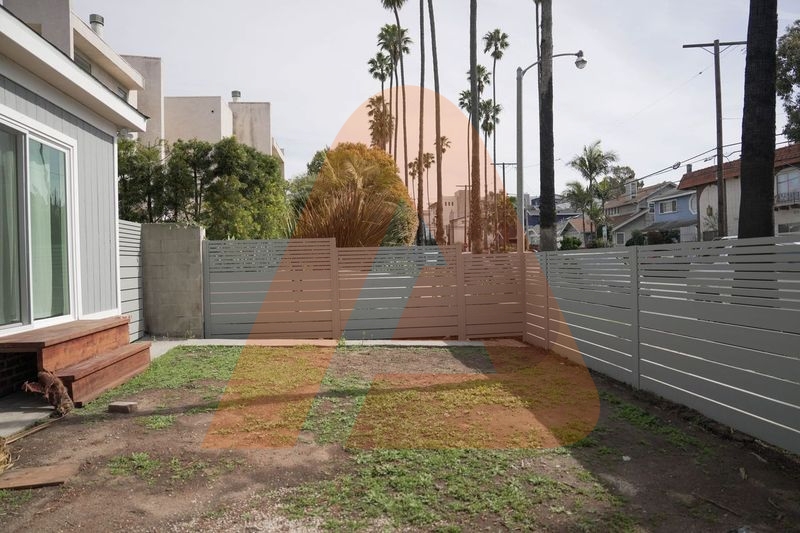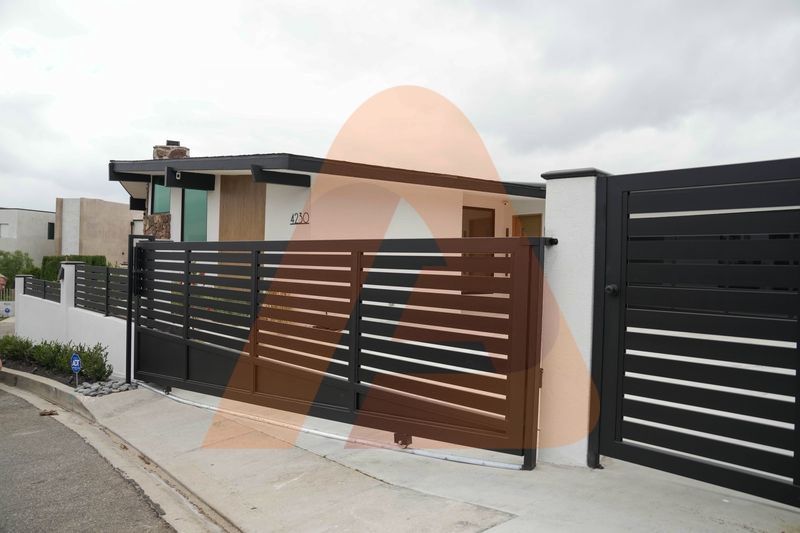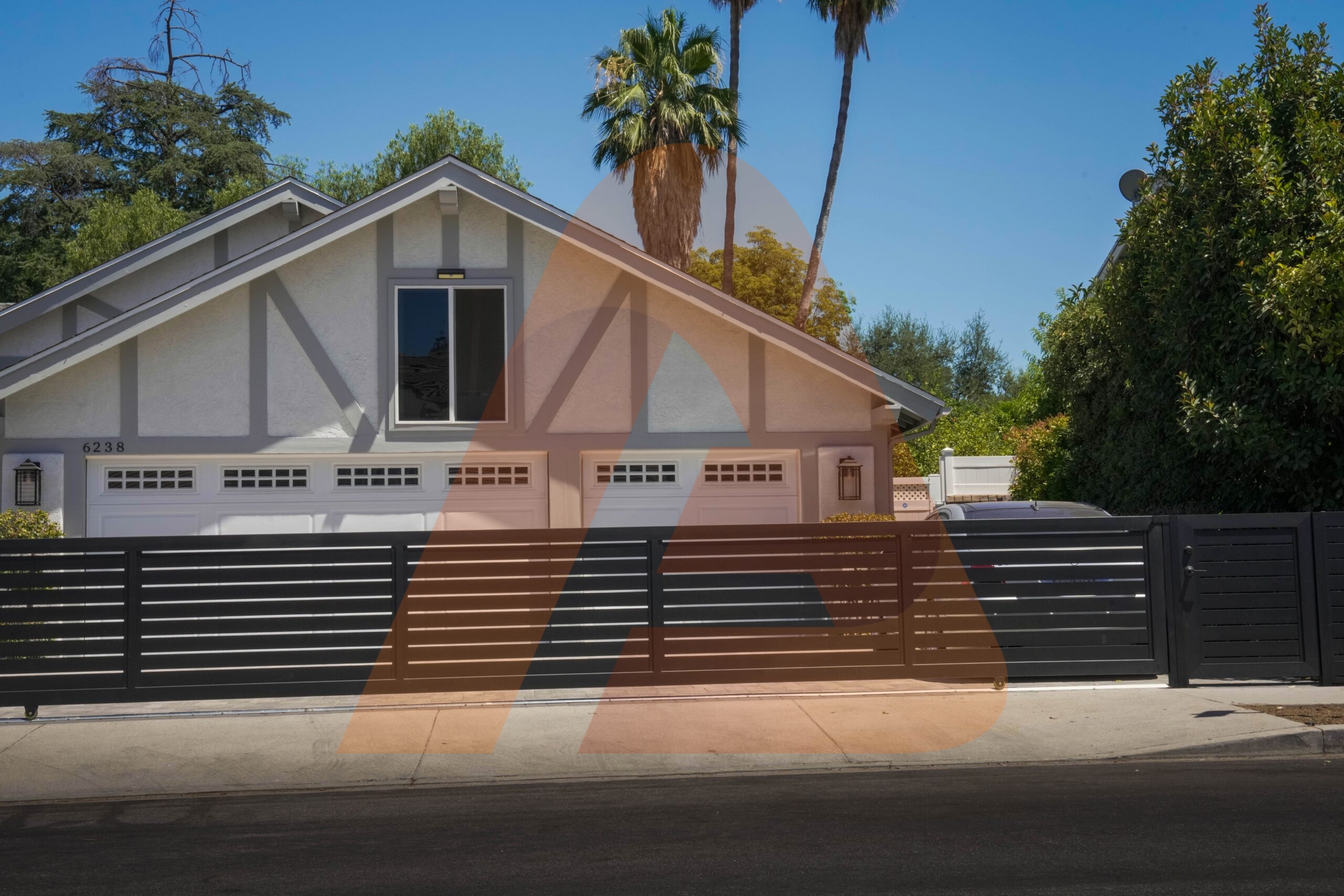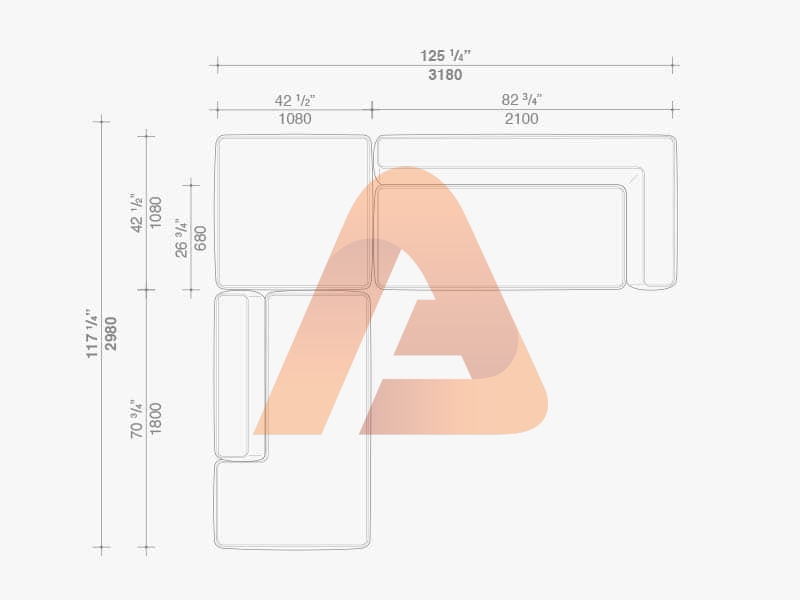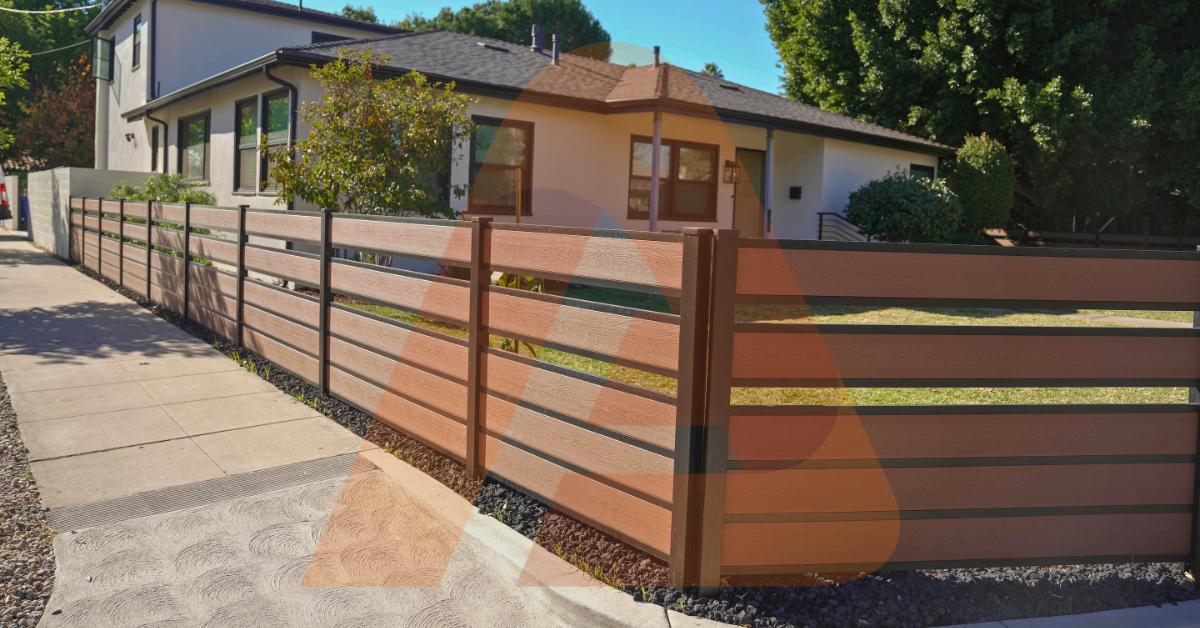
Horizontal Privacy Fences in Scottsdale: Modern Backyard Solutions
- By alupost
- Posted on
Table of Contents
Horizontal Privacy Fences in Scottsdale
Scottsdale homeowners choose horizontal privacy fences to achieve a sleek, modern aesthetic that visually widens outdoor spaces while delivering full coverage from street views, adjacent patios, and pool areas, and this linear orientation creates a strong architectural rhythm that complements desert-modern facades, stucco or masonry backdrops, and low-water landscapes with agave, palo verde, and decomposed granite, while also enabling precise control over sightlines, airflow, and shade through slat sizing, spacing, and layout that can transition from tight privacy zones to semi-private sections near entertaining areas, with materials ranging from low-maintenance aluminum or steel frames to warm horizontal wood fence infills that balance natural texture with contemporary geometry, and construction details like close post spacing, corrosion-resistant fasteners, UV-stable finishes, and strategic drainage/expansion gaps ensure panels stay straight and quiet in heat, monsoon winds, and daily thermal cycles so the fence remains a focal feature rather than a maintenance burden over time.
Why horizontal beats vertical in AZ yards
In Scottsdale’s intense sun and broad sightlines, the horizontal plane reads cleaner and calmer than vertical pickets by emphasizing the width of patios and pools, helping small yards feel broader and long lots feel more cohesive, while continuous horizontal runs can step or rack smoothly along grade to avoid awkward stair-stepping that interrupts the minimalist look, and the slat orientation also enables smart shading, casting lateral shadows that soften seating zones at peak afternoon hours and supporting micro-gapped designs that permit airflow without exposing views, all while accommodating mixed materials like wood-grain aluminum or sealed hardwood accents for warmth against a durable metal structure that resists warping, twisting, and color fade, thereby keeping lines crisp and maintenance simple in a climate where expansion, contraction, and UV breakdown challenge traditional assemblies.
Materials and finish options that last
Selecting the right assembly starts with the frame—powder-coated aluminum for lightweight, corrosion-resistant performance or galvanized/powder-coated steel for a heavier, ultra-solid feel—paired with infill planks chosen for both aesthetics and climate suitability, such as composite boards for uniform color and minimal upkeep, aluminum boards with wood-grain wraps for realistic texture without refinishing, or horizontal wood fence slats in cedar, redwood, or thermally modified wood sealed with UV inhibitors to slow color shift and surface checking, and finishes should prioritize matte or low-sheen coats that hide dust and hard-water spots while heat-reflective pigments and quality powder layers keep temperatures in check, with concealed fasteners, color-matched hardware, and metal edge trims refining the profile so long runs look like custom architectural elements rather than bolt-together panels, ensuring the fence reads as an intentional design choice that enhances both curb appeal and daily livability.

Installation and Build Quality
Achieving a modern horizontal privacy fence that endures Scottsdale’s heat and monsoon winds starts with a layout that respects lot lines, grade changes, utilities, and gate swing zones, then locking in a frame engineered for rigidity and thermal movement, using galvanized or powder-coated steel or aluminum posts set in deep footings with well-compacted gravel bases and properly mixed concrete to resist uplift and racking, followed by continuous rails or stout frames that keep long horizontal runs dead-straight, concealed fasteners that prevent streaking and hot-spot rust, and expansion gaps at hardscape interfaces so panels can breathe, while precise slat spacing and staggered seams reduce cumulative tolerance errors across large elevations, and careful gate planning—true jambs, square frames, and hardware rated for UV and dust—ensures quiet, reliable operation that won’t sag or bind after a season of temperature swings and wind.
Framing and post strategy
For long, horizontal spans, prioritize a structural backbone that won’t telegraph waves or dips by choosing heavier-gauge posts at corners and gate bays, adding mid-run stiffeners where winds funnel, and using continuous top caps or edge trims to keep the silhouette clean, with posts set below frost-free depths and raised slightly above final grade to protect coatings, while rails or channels capture slats without crushing fibers on wood or distorting composites, and metal frames are isolated from dissimilar materials to avoid galvanic reactions, producing crisp, shadow-line geometry that reads custom and remains tight through daily expansion and contraction.
Slats, fasteners, and finish details
Select slats that balance aesthetics with performance—powder-coated aluminum or steel boards for near-zero maintenance, composite for color uniformity and sound dampening, or sealed cedar/redwood for warmth—then align each course with a story pole to maintain consistent gaps, pre-drill ends to prevent splitting on wood, and use color-matched, corrosion-resistant fasteners that seat flush without crushing the surface, finishing with low-sheen coatings that reduce glare and hide dust, edge trims that protect plank ends from wicking and UV, and drain/weep detail at the base so water and fine grit shed cleanly, preserving the fence’s straight lines and premium finish over years of sun, wind, and occasional storm events.
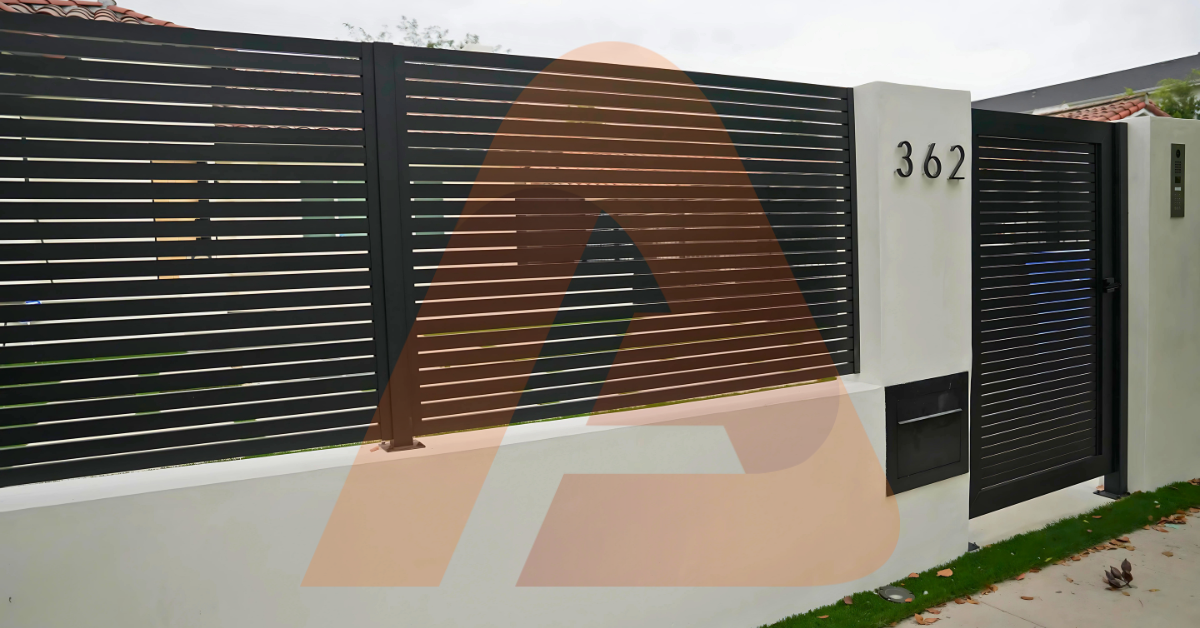
Permits, Heights, and Scottsdale Guidelines
Designing a horizontal privacy fence that looks modern and stays compliant in Scottsdale begins with mapping property lines, easements, and corner-visibility triangles, then planning front-yard sections that typically sit lower for sightlines while keeping side and rear runs at privacy height, and coordinating early with any HOA to align on materials, color, and slat spacing so approvals arrive before scheduling crews, after which the layout should account for grade transitions, drainage paths, and gate approaches to avoid puddling or binding, and the specification should call for structural posts sized for wind exposure, foundation depths appropriate to soil conditions, and coatings or sealers rated for intense UV, because these decisions reduce revisions, keep inspections smooth, and preserve the clean, continuous lines that make horizontal designs feel intentionally architectural rather than pieced together under pressure.
Scottsdale-friendly privacy strategies
To balance privacy with airflow and heat management, favor solid or near-solid zones where neighbors sit higher or overlook pools, then ease into micro-gapped sections near patios to move air during peak afternoon heat, and consider taller modules only where they do not obstruct driveway or corner views, using framed panels with concealed fasteners to avoid noise and hot-spot corrosion while specifying matte or low-sheen finishes that hide dust and water spots, with strategic step-ups at grade breaks to maintain a level top line from the street and integrated lighting or low-voltage conduits placed behind caps or in posts so the fence glows softly at night without exposing wire runs or compromising the minimalist profile.
Approval and scheduling tips
Submit a clear packet—site plan with dimensions, elevations with heights, material and finish cut sheets, gate specs with swing arcs, and notes on drainage and hardware—so review boards and inspectors can verify that the design respects setbacks and visibility requirements, then book installation toward drier windows to speed concrete cure and finish touch-ups, staging panels to avoid scratches and pre-assembling gates for square reveals, and finally, plan a post-install checklist to confirm latch alignment, uniform gaps, sealed cut edges, and protected transitions at masonry or stucco walls, ensuring the horizontal privacy fence delivers maximum curb appeal, quiet operation, and long-term stability without last-minute adjustments or costly rework.
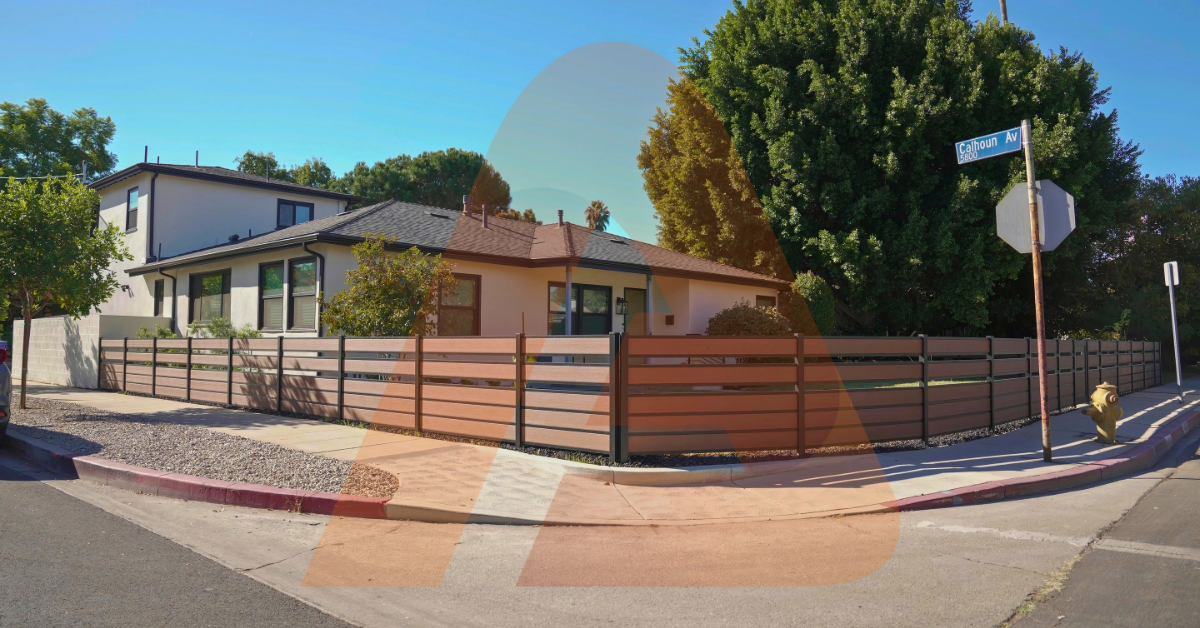
Long-Term Benefits and Property Value Impact
Installing Smart Gates in Murrieta homes offers more than immediate convenience—it provides lasting advantages that enhance both quality of life and long-term property value. As smart home adoption continues to rise, properties equipped with advanced access control systems consistently attract greater attention from buyers looking for secure and tech-savvy living spaces. A Smart Gate is not just a visual statement but a tangible investment that increases a home’s overall marketability. Potential buyers recognize the appeal of automated entry, integrated monitoring, and weather-resistant materials that require minimal upkeep. Studies have shown that smart technology installations often result in higher resale values due to the growing demand for connected properties, and Murrieta is no exception. In addition, Smart Gates contribute to lower homeowner insurance costs in some cases, as improved security systems reduce risk profiles. With AluGlobus Fence’s commitment to long-lasting construction and system reliability, Murrieta residents are choosing not just modern gates, but intelligent assets that continue to deliver benefits year after year.
Energy Efficiency and Cost Savings
One of the most understated advantages of Smart Gates lies in their sustainability and energy-conscious design. Many of today’s systems run efficiently using low-voltage motors and optional solar panels that significantly cut electricity costs while maintaining constant reliability. Murrieta’s sun-rich environment makes solar-powered automation an ideal option, offering energy independence and reducing environmental impact. Furthermore, smart sensors help gates operate only when necessary, minimizing wear on motors and extending their lifespan. Homeowners save money not just on energy consumption but also on maintenance, as diagnostic alerts and automatic performance checks prevent expensive repairs before they develop. This commitment to intelligent energy use aligns perfectly with the eco-aware direction Murrieta neighborhoods are moving toward—combining premium security with responsible, forward-thinking living.
Long-Term Durability and Peace of Mind
Durability is at the heart of why Smart Gates stand out as a superior choice for Murrieta homeowners. Designed with high-grade materials like weather-treated aluminum and stainless steel, these gates easily withstand Southern California’s diverse climate conditions. Unlike traditional mechanical gates that often require frequent servicing, Smart Gates are equipped with self-adjusting mechanisms and corrosion-resistant finishes that ensure flawless performance for years. The peace of mind they deliver comes not just from advanced security but from knowing the system will remain reliable and efficient long-term. AluGlobus Fence’s expert installation and post-service support provide additional confidence that every homeowner’s investment is protected. Over time, the combined effect of low maintenance, strong durability, and consistent performance turns Smart Gates into one of the most worthwhile home upgrades available in Murrieta—an investment that continuously enhances lifestyle, savings, and property value.
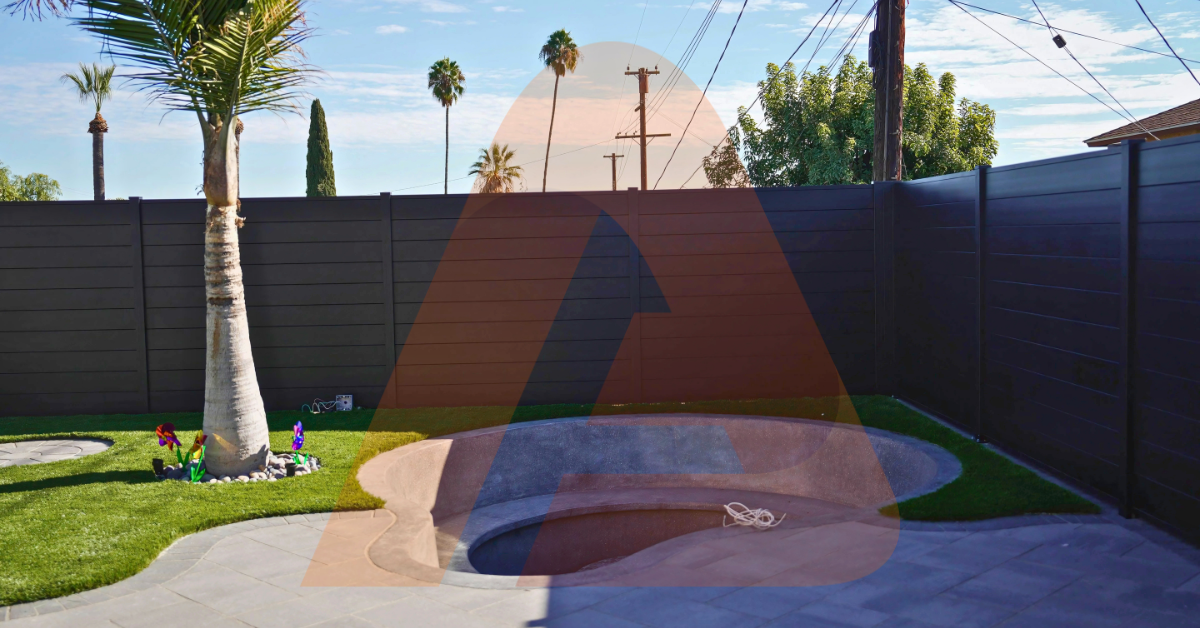
Maintenance and Longevity
Keeping a horizontal privacy fence looking modern in Scottsdale’s desert climate starts with designing for low upkeep and then following a simple, consistent care routine that protects finishes from UV, dust, and monsoon events; choose materials and coatings rated for high solar exposure, keep the bottom edge slightly above grade to prevent wicking and abrasion, and plan quarterly rinses to remove fine grit that can dull surfaces, then add an annual deep clean with mild soap and soft brushes to lift mineral spots without scratching, followed by hardware checks to tighten fasteners, re-lubricate hinges, and realign latches so long horizontal runs stay quiet, straight, and rattle-free despite daily temperature swings, while wood infills should be sealed with UV-inhibiting products and inspected for hairline checking, and any cut edges on metal or composite should be promptly sealed to maintain a continuous barrier against moisture and sun, ensuring the fence preserves its crisp geometry and rich color year after year in a region where lesser assemblies quickly fade, warp, or telegraph waves along the top line.
Scottsdale-ready care routine
Adopt a calendar-based plan that aligns with local weather by scheduling a thorough rinse before peak summer heat to remove spring pollen and dust, then repeat after the monsoon window to clear splashback and debris, and during each cycle wipe rails, caps, and slats with a pH-neutral cleaner to avoid streaking or sheen changes, touch up any cosmetic scuffs on powder-coated components with manufacturer-approved finishes, and re-seat any fasteners that have relaxed from thermal cycling, while keeping vegetation trimmed back so irrigation overspray and fertilizers don’t spot the surface, and maintaining clean drainage at the base so water and fine sand don’t linger against the lowest slat where abrasion can slowly erode the finish.
Long-term protection strategies
For wood-forward designs, plan periodic resealing based on exposure—south- and west-facing elevations may need shorter intervals—using breathable, UV-stable products that slow color shift and reduce surface checking, while composite or aluminum infills benefit from low-sheen, heat-reflective finishes that minimize glare and surface temperature, and all assemblies gain lifespan when dissimilar metals are isolated to prevent galvanic reactions, when concealed fasteners are used to limit streaking and corrosion points, and when posts and frames are capped or sealed at cut ends to block moisture pathways, resulting in a horizontal privacy fence that remains structurally tight, visually aligned, and refreshingly low-maintenance even as Scottsdale’s seasons test materials with intense sun, dust, and intermittent storms.

Design, Style, and Gate Pairing
A successful horizontal privacy fence in Scottsdale starts with an intentional design language that flows from street frontage to backyard living spaces, which means committing to a slat rhythm that aligns with the home’s architecture—tight, uniform spacing for minimalist desert-modern facades or mixed-width courses for a crafted, boutique feel—while carrying that rhythm across long runs with consistent top lines, perfectly aligned seams, and concealed fasteners so the assembly reads as one continuous architectural element rather than a collage of panels, and then selecting a finish palette that balances heat and glare control with visual warmth, favoring matte blacks, bronzes, and earth tones that sit comfortably alongside stucco, stone, and xeriscape while reducing dust visibility, with edge trims and caps that frame the silhouette cleanly, sound-dampening details at gates to eliminate rattle in afternoon winds, and careful alignment at grade transitions to keep sightlines calm and level from the curb and patio alike even as terrain steps or subtly rakes.
Gate layouts that feel custom
Gate planning should mirror the fence’s geometry with frames that maintain the same slat rhythm, rail reveals, and finish so openings feel integrated rather than afterthoughts, which begins by placing walk gates where foot traffic naturally flows and sizing them for comfortable passage and hardware swing arcs, then coordinating driveway gates to echo the fence’s proportions with reinforced hinge posts, properly rated hinges and latches for high-UV, dusty conditions, and soft-close or automated operators where convenience and quiet operation are priorities, all while maintaining the top-line continuity across the fence-to-gate transition, tucking conduits for lighting or operators inside posts or under caps to hide runs, and setting thresholds slightly above grade so water, grit, and decomposed granite don’t bind hardware after monsoon splashback or irrigation cycles.
Finishes, accents, and lighting
Finishes should prioritize UV-stable, low-sheen coatings that mute reflection and heat while preserving rich, even color across seasons, with aluminum or steel frames powder-coated to resist chalking and wood or composite slats finished in breathable, UV-inhibiting products that slow color shift and reduce surface checking, and accents should be restrained and purposeful—think slim top caps that sharpen the profile, color-matched fasteners that disappear visually, and metal edge trims that protect slat ends—while integrated low-voltage lighting can wash the horizontal lines with soft, indirect glow from beneath caps or within post cavities, elevating nighttime ambiance without exposing wiring or hardware, and house-number plaques, parcel pass-throughs, or keypad pedestals should be sized and finished to the same palette so the entire assembly reads cohesive, modern, and maintenance-ready for Scottsdale’s sun, dust, and occasional storm events.
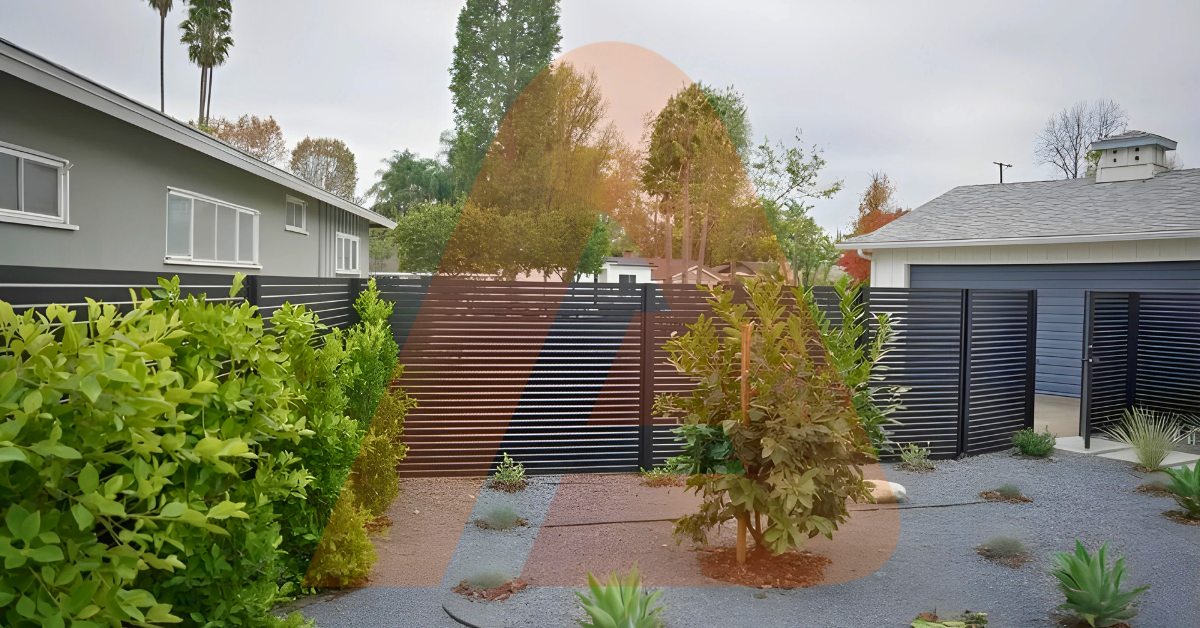
Installation Timeline and Workflow
Building a horizontal privacy fence that looks seamless and stays true in Scottsdale begins with a meticulous timeline that front-loads planning and streamlines field work, starting by verifying property lines, easements, utility mark-outs, and HOA or municipal requirements, then locking final elevations that maintain a calm, level top line across grade changes while preserving driveway and corner visibility, after which procurement secures posts, frames, slats, fasteners, finishes, gate hardware, and any automation components in matching palettes to avoid batch sheen shifts, and site prep clears vegetation, sets string lines, and marks gate swing arcs before deep-setting galvanized or powder-coated metal posts in compacted gravel and properly mixed concrete, followed by a cure window that protects alignment, then framing with continuous rails or rigid channels that capture slats without crush or rattle, and finally methodical slat installation using a story pole to hold exact gaps and reveals, concealed fasteners for a monolithic look, edge trims and caps to protect cut ends, and a closeout pass that aligns latches, lubes hinges, seals exposed cuts, polishes surfaces, and photographs elevations at consistent angles and light so the finished fence reads as a single, intentional architectural element.
Phased sequencing for clean results
A phased approach prevents rework and preserves finish quality by grouping tasks into logical, quality-controlled blocks, beginning with layout and post setting under stable weather so concrete cures evenly and posts stay plumb, then dry-fitting rails and test-installing a representative slat bay to validate spacing, thermal expansion gaps, and wind-stiffness before committing to full runs, after which production slat work proceeds in long, uninterrupted stretches to keep horizontal lines laser-straight, with daily checkpoints for top-line continuity, gate reveal uniformity, and surface protection, and only then moving to gates—pre-squared frames, dust- and UV-rated hinges and latches, soft-close or operator integration where specified—finishing with trim, touch-ups under consistent daylight to catch sheen mismatches, and a maintenance handoff that details rinsing cadence, approved cleaners, and inspection intervals so the fence stays quiet, straight, and color-true across seasons.
Scheduling and logistics that save time
Smart scheduling locks in drier windows for post-setting and coating work, sequences trades to avoid stacking crews in tight corridors, and stages materials in padded, shaded zones to prevent micro-scratches or heat warping, while cutting lists and standardized module widths reduce field trims and waste, and early gate templating avoids last-minute hinge relocations or latch shimming; on active properties, plan noisy drilling and concrete deliveries outside peak household use, coordinate operator power and low-voltage lighting runs before slat closures to hide conduits, and build in a mid-project inspection to approve sightlines and heights before finalizing the longest runs, ensuring the installation finishes on schedule with crisp geometry, smooth gate action, and a low-maintenance surface ready for Scottsdale’s sun, dust, and occasional storm events.
Shade, Privacy, and Airflow Balance
Designing a horizontal privacy fence that truly works in Scottsdale means treating shade, privacy, and airflow as a single system rather than separate features, starting with a slat rhythm that tightens in high-exposure zones facing neighbors or streets to create full visual coverage while easing into micro-gapped runs around patios and pools to move hot air without revealing key sightlines, then sizing gate openings and transitions so the top line remains calm and continuous even as the yard steps or subtly rakes, and finishing with low-sheen, UV-stable finishes in desert-friendly tones that mute glare and heat while hiding dust, which all together preserves comfort at peak sun, keeps the yard visually expansive, and delivers the minimalist, monolithic look that defines modern desert design across long elevations and corner turns.
Zoned layouts for comfort
A zoned layout begins by mapping activity areas and sun paths, using solid or near-solid panels to shield seating, spas, and outdoor kitchens where privacy and shade matter most, then introducing ventilated modules with micro-gaps near circulation paths and lounge zones to promote breezes during late-afternoon heat, and aligning each zone with consistent slat datum lines so the eye reads one cohesive fence rather than stitched-together segments, while small step-ups at grade changes maintain a level top profile from the curb and terrace, reducing the visual “noise” that can make outdoor rooms feel smaller and hotter than they are.
Heat-smart materials and finishes
Materials and finishes should prioritize performance under intense UV and dust, pairing powder-coated aluminum or galvanized/powder-coated steel frames with aluminum or composite slats for low maintenance and color stability, or sealed cedar/redwood where warmth is desired and scheduled resealing is acceptable, and all surfaces benefit from matte or satin sheens with heat-reflective pigments that keep temperatures down and reduce glare, with concealed fasteners and color-matched hardware preserving the uninterrupted horizontal geometry, and edge trims, caps, and sealed cut edges blocking moisture, grit, and sun from vulnerable points so lines stay crisp, operation stays quiet, and the fence continues to look intentionally architectural season after season.
Cost and Value Considerations
| Aspect | Key Details | Practical Tips | Impact on Budget/ROI |
|---|---|---|---|
| Scope & Site Factors | Total linear footage, target height, gate count/widths, terrain complexity, demo needs, and hardscape tie-ins set the baseline for logistics and labor across the entire build. | Measure perimeter precisely, locate utilities early, and plan gate placements where traffic naturally flows to reduce change orders and avoid rework during installation. | Accurate scoping minimizes surprises, shortens install time, and keeps material orders tight, lowering overall project cost while preserving timelines. |
| Material Strategy | Powder-coated aluminum or steel frames with composite or aluminum slats cut maintenance and repaint cycles; horizontal wood fence infills offer warmth but require periodic sealing. | Choose low-sheen, UV-stable finishes; pair metal frames with composite/aluminum slats for durability, and reserve wood accents in targeted elevations for texture. | Lower long-term upkeep and fewer refinish cycles improve lifecycle value; selective wood usage preserves aesthetics without inflating maintenance budgets. |
| Finish & Coatings | High-UV, matte coatings resist chalking and hide dust; sealed wood slows color shift and surface checking under desert sun and temperature swings. | Specify heat-reflective pigments and manufacturer-approved touch-up systems; calendar resealing for wood on sun-exposed elevations. | Finish stability reduces cleaning frequency and keeps the fence photo-ready, supporting curb appeal and resale impressions. |
| Structural Choices | Post gauge/spacing and mid-run stiffeners control deflection on long horizontal lines; rackable systems handle grade transitions cleanly. | Use heavier posts at corners/gates, add stiffeners in wind corridors, and standardize panel modules to reduce cutting waste. | Fewer cosmetic corrections and straighter sightlines over time, lowering labor and preserving the modern, monolithic look. |
| Gates & Hardware | Automation, soft-close hinges, and custom widths add performance and cost; dust- and UV-rated components ensure quiet, reliable operation. | Pre-build gates square, align reveals with fence rhythm, and protect thresholds from grit and splashback to prevent binding. | Smooth operation reduces callbacks and extends hardware life, improving perceived quality and owner satisfaction. |
| Scheduling & Phasing | Drier windows accelerate concrete cure and finishing; staged panels prevent scratches and keep coatings pristine during handling. | Sequence posts, frames, then slats; finalize touch-ups under consistent light to catch minor sheen or alignment issues. | Efficient scheduling reduces site time and finish rework, protecting budget and ensuring a predictable handoff. |
| Design Efficiencies | Standardized modules, consolidated gates, and minimized field cuts streamline fabrication and installation workflows. | Unify slat widths where possible, maintain consistent top lines, and pre-plan transitions at steps and rakes. | Material savings and faster installs increase cost control without sacrificing the clean, architectural aesthetic. |
| Long-Term ROI | Clean sightlines widen patios visually; durable finishes maintain uniform color and geometry despite heat, dust, and storms. | Confirm height/visibility rules and approvals early to avoid redesign; choose materials that resist warping and fade. | Lower maintenance, stronger resale photos, and fewer service calls convert style decisions into durable value. |
Budgeting for a horizontal privacy fence in Scottsdale starts by mapping scope to the site’s realities—overall linear footage, desired height, gate count and widths, terrain complexity, and any demo or hardscape tie-ins—then choosing materials and finishes that balance upfront price with lifecycle value in a high-UV, dusty, and occasionally stormy climate, where powder-coated aluminum or steel frames with composite or aluminum slats typically reduce maintenance and repaint cycles compared to raw wood, while premium horizontal wood fence infills like cedar or redwood deliver warm texture but require scheduled sealing to sustain color and resist surface checking, and costs can be streamlined through design efficiencies such as standardizing panel modules to minimize cutting waste, consolidating gates to fewer, well-placed openings, specifying rackable systems to handle subtle grade shifts without heavy shimming, and planning installation during drier windows to speed concrete cure and reduce return trips, all of which help keep the project on schedule, maintain the fence’s crisp geometry, and protect long-term curb appeal that supports property value in neighborhoods where modern lines and finish quality are highly visible.
Budget drivers to plan around
Major cost drivers include panel style and slat width (tighter, full-privacy layouts use more material and require stricter tolerances), finish quality (low-sheen, UV-stable coatings cost more but hide dust and resist chalking), post gauge and spacing (wind exposure and long runs may require heavier posts and mid-run stiffeners), and gate specifications (automation, soft-close hinges, and custom widths add hardware and fabrication time), and labor can vary based on obstacles like utilities, existing walls, and tree roots, as well as the precision needed to align long horizontal lines across stepped terrain, so early measurement, a clear elevations set, and standardized hardware selections reduce change orders while preserving the minimalist look that makes horizontal designs feel tailored rather than improvised.
Where horizontal fences deliver ROI
Return on investment shows up in the daily experience—clean sightlines that visually widen patios and pools, reliable privacy around seating and spa areas, and a finish that stays uniform through heat and dust—alongside reduced upkeep when frames and slats are chosen for Scottsdale’s conditions, because powder-coated metals and quality composites cut down on sanding, repainting, and board replacement while still allowing wood-forward accents where warmth matters, and by coordinating approvals early, confirming height and visibility requirements, and choosing materials that resist warping and color fade, homeowners secure a fence that enhances resale impressions, photographs beautifully for listings, and remains structurally quiet and visually aligned for years, turning a style decision into a long-term, value-forward upgrade.
Design Your Ideal Fence & Gates Today!
Bring your vision to life with premium aluminum fencing, custom gates, and modern cladding solutions crafted to elevate any property.
Schedule A ConsultationShopLayout, Setbacks, and Sightlines
A high-performing horizontal privacy fence starts with a plan that respects Scottsdale’s typical visibility and setback expectations while preserving the calm, level top line that makes modern designs feel intentional, so map exact property lines, easements, and utilities, establish a consistent datum for slat courses that can step subtly at grade changes without breaking the eye’s rhythm, and use tighter spacing in high-exposure edges while easing to micro-gaps near patios for airflow, then place gates where circulation naturally occurs and size them for hardware swing arcs and vehicle clearances, all while coordinating early with any HOA design language on materials and colors to avoid redesigns and scheduling friction, and specifying UV-stable, low-sheen finishes with color-matched, concealed fasteners so the fence reads as one continuous architectural element from street frontage through poolside zones even as terrain, sun paths, and wind corridors shift across the site.
Street-facing and corner conditions
For street frontage and corner lots, prioritize sightlines by maintaining lower or stepped profiles at driveways and intersection approaches while reserving full privacy height for side and rear perimeters, and keep the top line visually unbroken by staging small, consistent step-ups at grade transitions rather than abrupt stair-steps, which also reduces wind eddies that can create whistle or rattle at gaps; use reinforced posts at corners and gate bays, integrate edge trims to protect slat ends from UV and grit, and maintain a modest ground clearance to prevent wicking and abrasion from decomposed granite or splashback during monsoon events, ensuring clean geometry and quiet operation.
Pool, patio, and service zones
Around pools and patios, concentrate full-privacy modules where neighbors overlook seating or spa areas, then transition to ventilated, micro-gapped runs that move hot air and soften late-afternoon exposure without revealing key sightlines, aligning all slat courses to a shared datum so the assembly feels monolithic rather than patched; in service corridors and utility access points, standardize gate widths, specify dust- and UV-rated hinges and latches, protect thresholds from grit accumulation, and conceal conduits for lighting or operators inside posts or beneath caps, which preserves the minimalist profile, speeds maintenance access, and keeps the entire system coherent, durable, and low-maintenance across seasons.
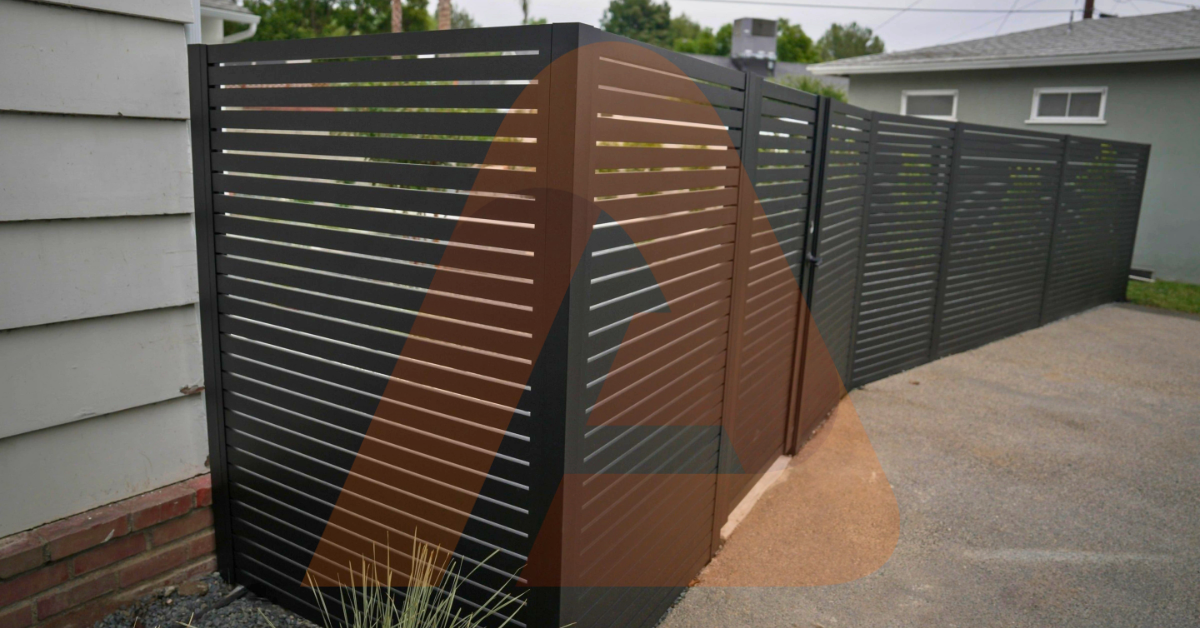
Hardware, Safety, and Code Planning
Building a horizontal privacy fence that feels truly finished in Scottsdale includes a hardware and safety strategy that is specified as carefully as the slats and frames, beginning with hinges and latches rated for high UV, dust, and temperature swings so gates operate quietly and reliably even after a summer of thermal cycling, then selecting soft-close or self-closing mechanisms where pool safety or quiet operation is important, and confirming that latch heights, gate swing direction, and clearances meet applicable safety guidelines while still aligning with the fence’s minimalist rhythm, after which all hardware should be color-matched to the frame finish and installed with concealed or low-profile fasteners to preserve clean lines, and any cut edges must be sealed to protect against corrosion and dust ingress, with thresholds detailed to sit slightly proud of grade so decomposed granite, grit, and irrigation splashback don’t bind the leaf over time, resulting in gates and panels that not only look monolithic from the street but also stand up to daily use without squeaks, rattles, or misalignment.
Gate configurations that work
Gate configurations should follow the site’s circulation patterns and service needs by placing walk gates where foot traffic naturally concentrates and driveway gates where turning radii and approach angles allow smooth entry, then sizing widths for comfort and code considerations while reinforcing hinge and latch posts to resist sagging and racking across long horizontal runs, and integrating strikes, receivers, and stops that are aligned to the same slat datum as the fence so the visual language carries through the opening, with operators or access control planned early so conduits can be hidden in posts or beneath caps, weather shrouds can be integrated without visual bulk, and emergency release locations remain intuitive and reachable; finally, protect gate thresholds from debris accumulation with subtle grading away from the swing path and choose wear-resistant bushings or bearings to maintain quiet, precise motion season after season.
Safety details without visual clutter
Delivering safety without breaking the modern aesthetic starts with setting latch heights that remain reachable yet tamper-resistant, choosing low-sheen finishes that reduce glare around pathways, and maintaining consistent ground clearance to avoid toe-stubbing while still preventing wicking into the lowest slat, then adding discreet edge trims to protect corners at high-touch areas, specifying rounded cap profiles where kids play, and including soft-close dampers to keep wind gusts from slamming leaves in monsoon season; where pool zones are present, use self-closing, self-latching hardware with outward swing away from the water and ensure the latch release is shielded from easy reach, all while keeping the top line level and uninterrupted so the fence reads as one continuous, intentional element that quietly meets safety expectations without sacrificing the minimalist, horizontal design language.

Lighting, Tech, and Access Control
Integrating lighting and access control into a horizontal privacy fence in Scottsdale works best when these systems are planned with the same precision as slat rhythm and gate geometry, beginning with low-voltage, warm-white fixtures that wash across the horizontal lines without glare and nest inside post cavities, under top caps, or along discrete edge channels so wiring remains concealed and maintenance points are accessible, then layering pathway and step illumination near gates to guide nighttime circulation while preserving the fence’s calm silhouette, and coordinating smart controls—timers, photocells, and app-based dimming—to adapt brightness through the evening as temperatures fall, after which access control should mirror the minimalist aesthetic with compact keypads, RFID readers, or video doorbells mounted on purpose-built plates finished to match the frame, conduit runs pre-pulled before slat closure, and strike/latch hardware specified for dust, heat, and daily use so entry feels seamless and durable, all while ensuring power supplies, junctions, and batteries live in ventilated, discreet enclosures that shed heat and dust and allow quick service without interrupting the uninterrupted horizontal datum that defines the design.
Discreet lighting that shapes space
Aim for indirect, shielded lighting that grazes the fence rather than spotlighting it by using linear LED strips beneath caps to create a soft crown glow, downlights tucked into posts to paint subtle verticals that anchor the horizontals, and low-profile markers at gate thresholds to define safe passage without producing hot spots or harsh shadows, and select color temperatures in the 2700K–3000K range to flatter desert materials while avoiding bluish tints that increase perceived glare, pairing dimmable drivers and smart schedules for late-night setback levels that preserve dark-sky sensibilities and reduce bug attraction, and consolidating drivers and transformers in serviceable, shaded locations with labeled circuits so future maintenance is quick, clean, and doesn’t require removing slats or disturbing the fence’s finished faces.
Clean access with hidden infrastructure
Access systems should be engineered into the frame from day one by allocating interior post space for conduits, drip loops, and strain relief so cables don’t telegraph through slats, then specifying weather-rated keypads and readers with tactile feedback and backlit numerals that remain legible in dust and heat, with strike plates aligned to the slat datum and magnetic or mechanical latches tuned for soft, precise closure, while driveway gates benefit from operators sized for wind load and cycle frequency, battery backups for storm resilience, and safety devices—photo eyes and edge sensors—positioned discreetly but in compliance, and all devices should share a coordinated finish palette and mounting hardware so the technology disappears visually, letting the fence’s horizontal geometry remain the hero while daily use stays effortless, secure, and quiet.
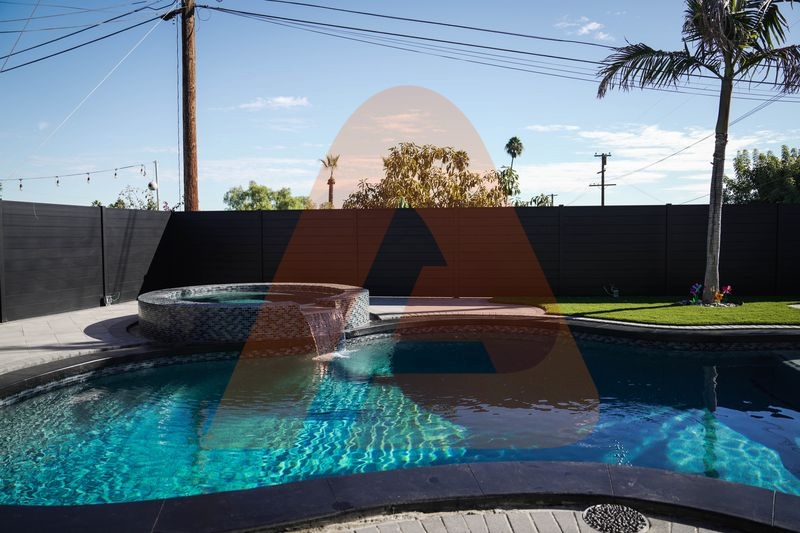
Material Pairings and Aesthetics
A refined horizontal privacy fence in Scottsdale benefits from thoughtful material pairings that balance architectural warmth with desert-ready durability, starting with a powder-coated aluminum or galvanized steel frame that delivers straight, stable lines across long runs and resists chalking, then selecting infills that express the home’s design language—aluminum slats with subtle wood-grain wraps for low-maintenance texture, composite boards for uniform color and sound dampening, or horizontal wood fence slats in cedar, redwood, or thermally modified options sealed with UV-inhibiting finishes—while coordinating a cohesive, low-sheen palette of matte blacks, deep bronzes, or earth neutrals that mute glare and dust, using concealed fasteners and color-matched hardware so the surface reads monolithic, edge trims and top caps to protect cut ends and sharpen silhouettes, and disciplined slat rhythms that carry around corners, step gracefully along grade changes, and align perfectly at gates, producing a continuous, modern datum that looks intentional from curb to courtyard and holds its profile under sun, wind, and seasonal temperature swings.
Wood-forward designs done right
When prioritizing a horizontal wood fence aesthetic, specify stable species like cedar, redwood, or thermally modified lumber milled with consistent thickness to avoid cumulative tolerance creep, then pre-seal boards—including edges and ends—with breathable, UV-stable products before installation to slow color shift and minimize surface checking, lay out courses with a story pole to keep gaps perfectly uniform, and isolate wood from soil and irrigation splash with a modest ground clearance and protective trims so fibers don’t wick moisture or accumulate grit, while hidden fasteners or color-matched screws driven to a consistent depth prevent telegraphed dimples across long lines, and periodic, calendar-based resealing focused on south- and west-facing elevations preserves tone and grain clarity without interrupting the fence’s calm, minimalist geometry.
Metal and composite for minimal upkeep
For the lowest maintenance in Scottsdale’s high-UV, dusty conditions, pair a powder-coated aluminum or steel frame with aluminum or composite slats finished in matte or satin sheens that hide dust and resist heat build-up, specify rackable or channeled systems that capture boards without crushing edges, and use expansion allowances at long runs and hardscape interfaces so thermal cycling doesn’t introduce waves, then finish with color-matched, corrosion-resistant fasteners, sealed cut edges, and discreet edge trims that shield end grain and joint lines, creating a quiet, rattle-free assembly that holds color uniformity and straightness through summer extremes, monsoon splashback, and daily temperature swings while preserving the sleek, horizontal datum that defines modern desert design.
Design Your Ideal Fence & Gates Today!
Bring your vision to life with premium aluminum fencing, custom gates, and modern cladding solutions crafted to elevate any property.
Schedule A ConsultationShopDrainage, Cleaning, and Surface Care
Designing a horizontal privacy fence that stays crisp in Scottsdale long-term means planning for water, dust, and mineral management from day one, starting with a modest ground clearance and discrete weep paths at the base so monsoon splashback and irrigation overspray shed away instead of wicking into the lowest slat, then specifying low-sheen, UV-stable finishes that hide dust and resist chalking while making quarterly rinses more effective, and organizing a care routine that uses pH-neutral cleaners, soft brushes, and non-marring cloths to lift mineral spots without scratching, with sealed cut edges, protected end grain, and color-matched touch-up systems ready for quick cosmetic fixes, all of which preserves straight sightlines, prevents creaks or rattle from grit buildup, and keeps the fence reading as a single, intentional architectural element across seasons.
Drainage and dust control details
Begin by grading hardscape and planter edges to fall away from the fence line, leaving consistent clearance below the bottom course so decomposed granite and fine sand don’t accumulate against slats, then add subtle weep allowances behind trims and at post bases to release trapped moisture after storms, and position irrigation heads to avoid direct spray that can spot finishes or accelerate wood movement, while periodic blower passes or soft rinses remove dust before it abrades coatings, and rubber or felt pads during staging and maintenance prevent micro-scratches that would otherwise telegraph along the fence’s calm, horizontal datum.
Cleaning cadence and finish protection
Adopt a calendar-based routine that schedules a thorough rinse before peak summer heat and a second after monsoon season, using pH-neutral soap for stubborn debris and microfiber cloths to avoid sheen changes, then inspect hardware for torque and re-lubricate hinges to maintain quiet, precise motion, reseal wood-forward elevations on sunniest exposures as needed to slow color shift and surface checking, and promptly seal any fresh cuts or touch up minor scuffs with manufacturer-approved coatings so finishes remain uniform, edges are closed to moisture and UV, and the fence continues to look monolithic and modern without intensive upkeep or frequent refinishing.
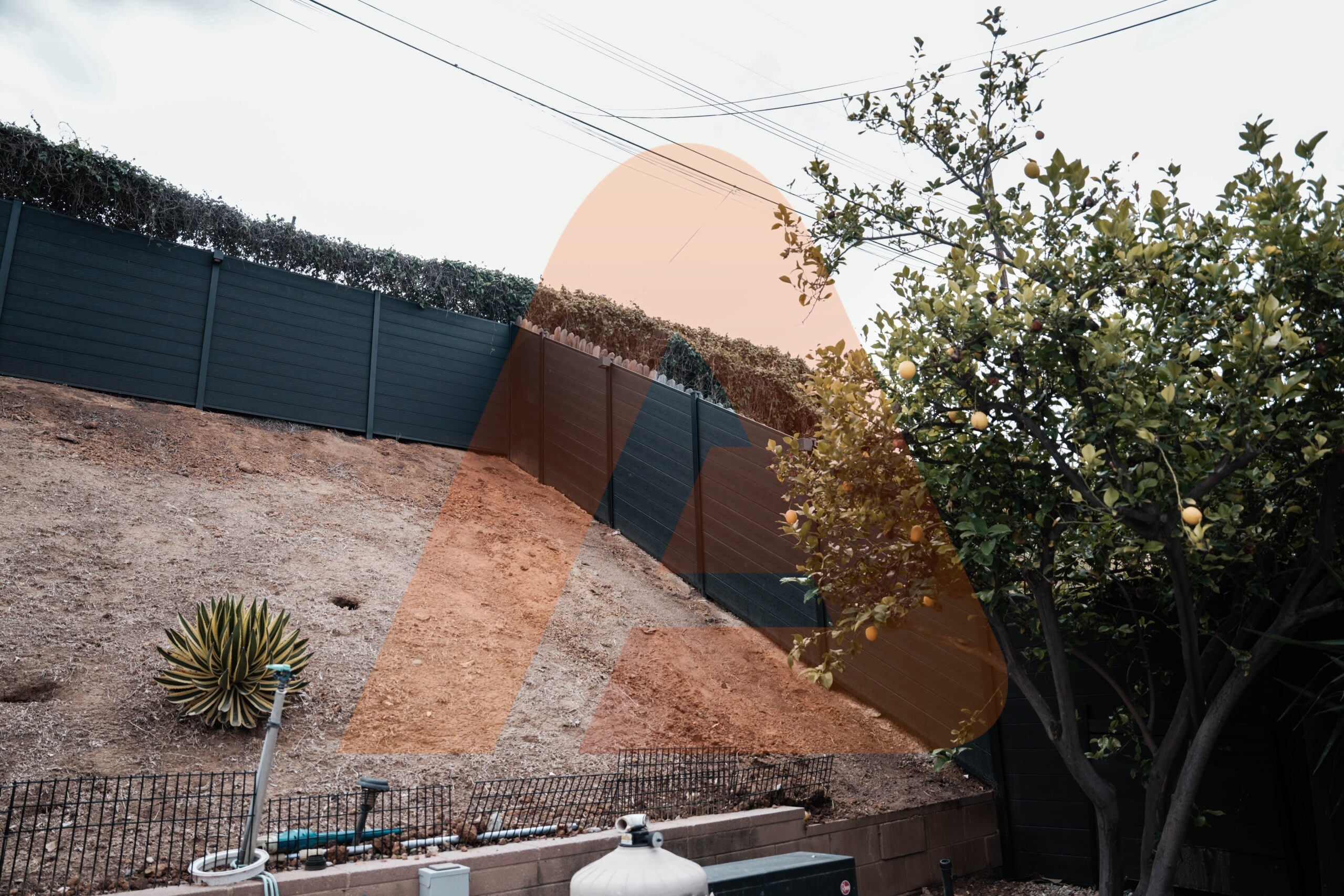
HOA Coordination and Approvals
Securing smooth approvals for a horizontal privacy fence in Scottsdale starts with a coordinated submittal that marries aesthetics to compliance, which means preparing a site plan that clearly marks property lines, setbacks, easements, and corner-visibility triangles, pairing it with elevation drawings that show overall heights, step locations, and a consistent slat datum, and attaching material and finish cut sheets that confirm UV-stable, low-sheen coatings and color-matched hardware so review boards can see that the design is both durable and visually coherent, while also including gate specifications with swing arcs, latch heights, and safety details for pool-adjacent areas, plus any lighting or access-control notes with concealed conduit routing, because this level of clarity prevents back-and-forth, avoids last-minute redesigns, and preserves the calm, horizontal geometry that gives the fence its modern, monolithic character from street edge to patio.
Submittal package essentials
A well-structured package should include measured site and landscape plans with dimensions, elevations showing top-line continuity and where steps occur on slopes, a schedule of posts, rails, slats, and fasteners with finishes and sheen levels, and a gate matrix listing widths, hardware ratings, latch locations, and any operator or keypad integration, along with a brief narrative that explains privacy zones versus ventilated micro-gap sections for airflow, the rationale for matte colors to reduce glare and dust visibility, and the strategy for drainage, ground clearance, and sealed cut edges, ensuring reviewers can confirm the fence meets neighborhood standards while maintaining the minimalist profile and performance needed for Scottsdale’s sun and seasonal storms.
Workflow to avoid delays
To keep timelines predictable, align the design early with neighborhood guidelines on height and materials, conduct a quick pre-check on driveway and corner visibility, and secure neighbor acknowledgments where shared lines are involved before final submittal, then sequence procurement only after approval so finish batches match across all elevations, and schedule posts and framing during drier windows for clean cure and plumb alignment; close with a documented punch list—gate reveals, latch alignment, finish touch-ups under consistent light, sealed edges at cuts, and verified drainage paths—so the fence turns over with crisp geometry, quiet operation, and a paper trail that satisfies both HOA conditions and homeowner expectations.
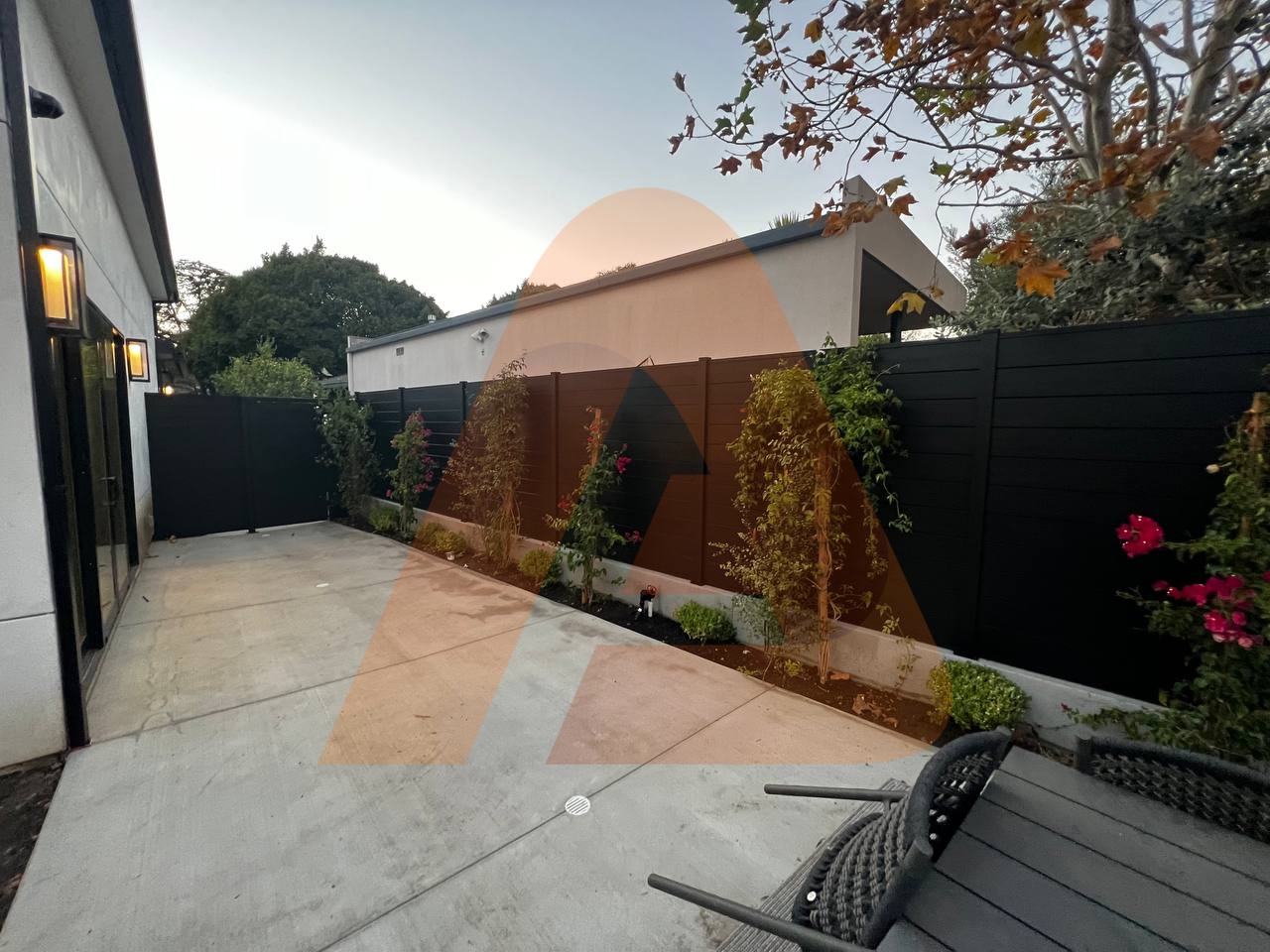
Post-Install Checks and Handover
A horizontal privacy fence delivers its best life when the project closes with a disciplined handover that verifies geometry, operation, and finish quality in real-world conditions, beginning with a slow, line-of-sight walk along each elevation to confirm the top line reads calm and continuous across grade transitions, that slat gaps remain perfectly uniform without cumulative tolerance drift, and that concealed fasteners sit flush without telegraphing dimples, then cycling every gate to check for square frames, smooth hinge motion, quiet latching, and proper clearances over decomposed granite or pavers so grit can’t bind the leaf, after which surface protection is validated by confirming all cut edges, penetrations, and trims are sealed, that matte or satin finishes are free of swirl or sheen mismatch, and that dust or irrigation spots wipe clean without streaking, followed by photographing elevations at consistent angles and light for records, and issuing a concise care guide that documents rinsing cadence, approved cleaners, hardware torque checks, and reseal intervals for any wood elements so the fence maintains its monolithic, modern profile through Scottsdale’s sun, dust, and occasional storm events.
Performance verification in real conditions
To ensure long-run stability, test the fence during the hottest part of the afternoon and again after temperatures drop, listening for expansion pops or panel rattle and confirming gates still latch without dragging, then inspect wind-exposed sections for deflection, add discreet stiffeners if needed, and verify that micro-gapped zones near patios move air without exposing unintended sightlines, while drainage gets a hose test to watch how water sheds at the base and off caps, adjusting ground clearance or weep details where splashback lingers, and finally, check lighting and access components at night to validate glare-free illumination, reliable keypad readability, and silent operator cycles so the technology disappears into the design.
Owner packet and maintenance calendar
Deliver a concise owner packet that includes as-builts with post locations and gate widths, finish data sheets with color and sheen codes for touch-ups, hardware specifications and warranty notes, and a seasonal maintenance calendar that schedules a pre-summer rinse and post-monsoon clean, hinge lubrication, fastener torque checks, and any wood resealing focused on south- and west-facing elevations, plus a quick troubleshooting guide for gate alignment, latch adjustments, and cosmetic touch-ups, ensuring the homeowner or property manager can keep the fence straight, quiet, and color-true with minimal effort while preserving the minimalist, horizontal datum that defines the project’s modern aesthetic.
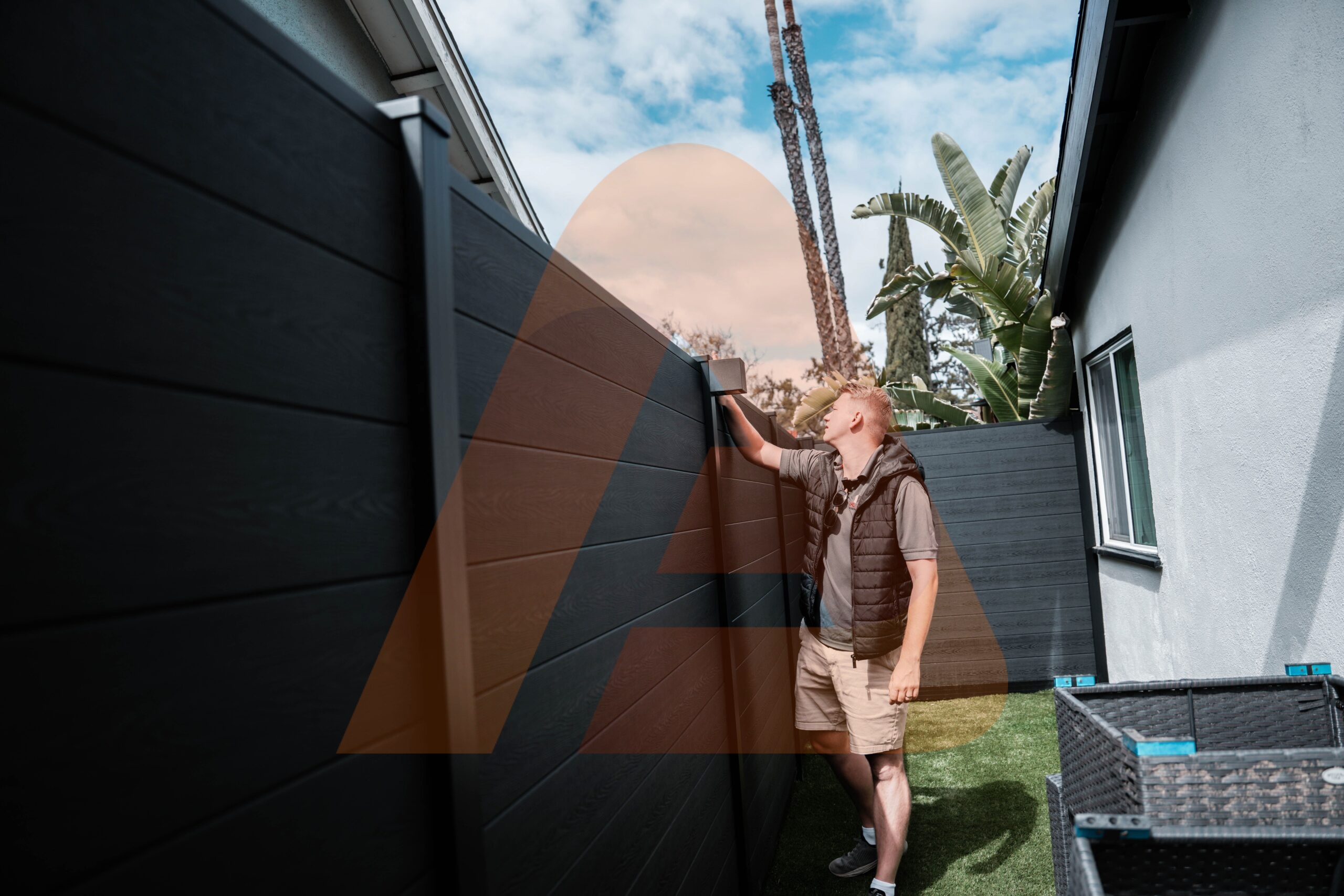
Neighbor-Friendly Screens and Transitions
Designing a neighbor-friendly horizontal privacy fence in Scottsdale means treating perimeter edges as shared visual space by softening exposures with strategic slat rhythms, stepped top lines that feel intentional rather than abrupt, and finish palettes that harmonize with adjacent façades and landscapes, beginning with tighter, full-privacy modules where windows or elevated decks create direct sightlines and then easing into micro-gapped segments to invite airflow near side yards, while carrying a consistent slat datum around corners so the fence reads as one calm, modern band instead of stitched sections, and integrating planting pockets or shallow trellis accents where appropriate to visually blend long runs without compromising maintenance or the minimalist aesthetic, with gate placements following natural circulation to limit foot traffic along shared boundaries, thresholds graded to shed grit and splashback away from neighbors’ hardscape, and hardware selected in low-sheen, color-matched finishes so the system remains quiet, unobtrusive, and architecturally coherent from both sides throughout seasonal temperature swings and occasional storm events.
Shared boundaries that feel intentional
On shared lines, prioritize symmetry by mirroring slat spacing and top-line continuity so both properties experience clean, uninterrupted geometry, keep the bottom course slightly off grade to prevent wicking and abrasion while aligning with adjacent hardscape elevations, and standardize post intervals to avoid odd bay widths that can telegraph as visual “hiccups,” then buffer service zones with ventilated modules that reduce heat buildup and echo the main rhythm, use concealed fasteners and sealed cut edges to prevent streaking and early wear visible from either side, and specify matte or satin finishes that mute glare and reduce dust visibility so daily views remain calm and consistent without drawing attention to fasteners, seams, or maintenance touch-ups.
Courtesy details that reduce impact
Add quiet-operating hinges, soft-close latches, and rattle-resistant gate stops to eliminate noise during early mornings or windy afternoons, coordinate lighting with indirect, shielded fixtures that graze horizontally rather than spotlight across boundaries, and keep access-control devices compact and color-matched with wiring hidden inside posts to avoid visual clutter, while setting a clear maintenance cadence—seasonal rinses, pH-neutral cleaning, hinge lubrication, and timely resealing for any wood elements—so the fence retains straight sightlines and even color, and establish simple neighbor notifications for installation phases and any major service visits to minimize disruption, reinforcing that the horizontal privacy fence is not just a barrier but a shared architectural asset that elevates both properties.
Final Thoughts for Scottsdale Homes
Choosing a horizontal privacy fence in Scottsdale pays off when modern lines, durable materials, and climate-ready finishes are aligned from the first sketch to the final punch list, because a well-planned system uses UV-stable, low-sheen coatings to hold color in intense sun, frames that keep long runs straight through thermal cycling, and concealed hardware that preserves the minimalist rhythm across steps, gates, and corners, while early coordination on heights, setbacks, and neighbor-facing edges prevents redesigns and keeps projects on schedule, and a simple maintenance cadence—seasonal rinses, pH‑neutral cleaning, hinge lubrication, and timely resealing for any wood accents—protects the fence’s monolithic profile and calming sightlines for years of daily use.
Design Your Ideal Fence & Gates Today!
Bring your vision to life with premium aluminum fencing, custom gates, and modern cladding solutions crafted to elevate any property.
Schedule A ConsultationShopFrequently Asked Questions
They perform well when built with powder‑coated aluminum or galvanized/powder‑coated steel frames, UV‑stable low‑sheen finishes, and expansion allowances at long runs, which together resist chalking, minimize glare, and keep lines straight despite daily temperature swings.
Powder‑coated metal frames paired with aluminum or composite slats deliver the cleanest, most durable result, while selectively using sealed cedar or redwood for accent zones adds warmth without committing the entire perimeter to frequent resealing.
Yes—use full‑privacy modules where screening is critical and micro‑gapped sections near patios or pools to move air, maintaining a single slat datum and level top line so the fence reads as one calm, continuous element.
Gates should mirror slat rhythm and finish, using reinforced hinge posts, dust‑ and UV‑rated hinges and latches, soft‑close or automated operators where needed, protected thresholds above grade, and concealed conduits so access stays quiet, precise, and visually clean.
Plan quarterly rinses and an annual pH‑neutral wash, tighten hardware, lubricate hinges, touch up minor scuffs with approved finishes, keep vegetation and irrigation overspray off surfaces, and reseal wood accents on sunnier exposures to preserve tone and prevent checking.


